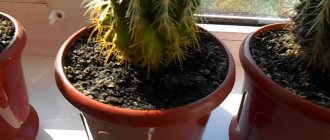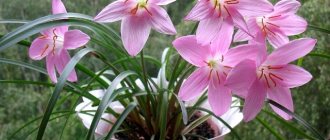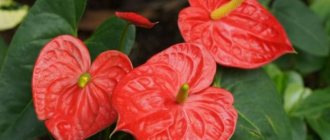Zephyranthes belongs to the Amaryllis family. The flower is native to Central America; its name can be translated as “flower of the western winds.” In different countries of the world it was given its own name ; the most popular names are water lily, or home daffodil.
It actually bears some resemblance to these flowers. In Russia, they gave it a comic name - upstart , and all because within a few days after abundant watering, a large number of inflorescences appear.
Growing in tropical latitudes, during the hot season the bulbs are dormant, but as soon as the rainy season begins, its vigorous growth and flowering begins . The plant has taken root well in our latitudes as a houseplant.
Name
Appearance of flowers
Marshmallow is not only a popular sweet, but also the name of a deity from ancient Greek myths. Later, this word began to be used to describe the warm, moist wind blowing from the Atlantic coast. The word "anthos" is translated from Greek as "flower". The homeland of the plant is South America.
Zephyranthes got its name because it blooms when the wind begins to blow zephyr from the Atlantic to the South American continent. The literal translation is “flower of the west wind.”
But zephyranthes also has a nickname - “upstart”. It owes its rapid growth to him: from the moment the peduncle appears until the first flowers bloom, not even a few days pass. The plant has other, more poetic nicknames: “water lily”, “rain flower”, “house daffodil”.
Rest period
In the description of caring for zephyranthes, it was repeatedly mentioned that the plant has a dormant period, which is especially pronounced in some of its varieties. If you do not allow it to rest and gain strength, it will continue to grow, but its appearance will be much to be desired - the flower will look tortured, and its buds will begin to shrink and soon will not appear at all. If signs of malaise are noticed, it may be enough to give the marshmallow some rest - put it in a cool place, reduce watering, and sometimes temporarily stop it altogether.
Dried leaves and buds must be promptly removed for sanitary purposes.
Description
Flowering in open ground
Zephyranthes is a herbaceous bulbous plant, a perennial of the Amaryllis family. Up to 40 species are found in nature, living in the tropical and subtropical regions of Central and South America. 10 of them are suitable for home breeding. Residents of these areas happily grow zephyranthes in their garden plots.
The bulbs are small in size, 1-5 cm in diameter, slightly elongated or ovoid in shape and covered with brown husk. The toxins they contain make them unattractive to parasites and pests. Narrow and oblong linear leaves of a dark green hue grow from bulbs.
Variety with pink flowers
Each bulb produces one or several tubular peduncles, their length reaches 30 cm or more. The flowers are solitary, single-row, funnel-shaped, 7-10 cm in diameter. They bloom almost simultaneously with the appearance of the leaves.
In nature, zephyranthes bloom at any time of the year, if the conditions are suitable. The flowers are colored pink, white, scarlet, purple or yellow. Some note that they resemble crocuses.
Difference from Gabranthus
What flowers does gabranthus have - photo
In the Amaryllidaceae family there is a flower similar to zephyranthes - gabranthus. Sometimes they are even called twin brothers. The differences are presented in table form:
It is interesting that in English both flowers are called the same: rain lily - “rain lily”.
Application and beneficial properties
Use in landscape design
Zephyranthes is a wonderful indoor plant and a convenient “resident” of a garden or summer cottage. Plants are also used to decorate landscapes. But in addition to decorative properties, zephyrantes also have healing properties.
Lycorin, naringin and other alkaloids and antioxidants contained in parts of the plant are used in therapy:
- Oncological pathologies
- Hepatitis and other liver diseases
- Diabetes mellitus
- Tuberculosis.
Marshmallows have also proven effective against colds. The plant is used not only in traditional medical practices, but also in official medicine.
Since marshmallow bulbs are poisonous, they should not be allowed to reach pets or children.
The soil
Neutral soil is suitable for zephyranthes. It is important that it is loose, has good air permeability and is nutritious.
You can buy a ready-made substrate for flowering indoor plants or prepare the mixture yourself. In the second case, you should choose one of the options:
- Turf and leaf soil, sand, peat - in equal parts;
- Sand, turf soil, humus - in equal proportions.
The soil should be disinfected before planting . The pot must have holes and a layer of drainage must be placed on the bottom.
Superstitions
Sharp and long leaves of the plant
The flower is surrounded by signs and folk beliefs. For example, it is believed that a plant has strong energy during the growing season - active growth and flowering.
Presumably, zephyranthes helps a person become more relaxed, courageous and self-sufficient. They also say that it strengthens the family, makes relationships more tender and warm.
However, the flower also has a bad reputation. In the teachings of Feng Shui, on the contrary, it is said that an “upstart” causes discord in family relationships, so it is undesirable to keep it at home, especially in the bedroom. Proponents of the doctrine believe that, in general, you should not have plants with long, sharp leaves at home.
Reviews
The plant is not capricious, it only requires watering, you need to water it moderately once a week or a little twice a week. Maintenance is, in principle, not difficult; the most that is needed is to remove the yellowed stems and periodically loosen the soil. I replant it twice a year, in autumn and spring, next spring I will divide the bush, since it has grown very much. It blooms beautifully, I like it very much, such cute bells, the color is delicate, white, and the flowers themselves are very delicate, it’s a pity that they just fade quickly, they bloom for a maximum of two days, but new flowers appear every day, so it’s not a problem, and always You can save this beauty in the photo.
MaryaHr88 https://citykey.net/review/ochen-nezhnye-i-krasivye-tsvetochki-u-nego
White zephyranthes produces a lot of flowers, I threw them away one after another, the flowers are large, delicate, but it’s a pity that they fade quickly. There is absolutely no fuss with it, the main thing is to replant and seat it on time.
maryahramlyuk https://otzyvy.pro/reviews/otzyvy-komnatnoe-rastenie-zefirantes-25580.html
Between flowering periods, Zephyranthes Lindleya looks completely unremarkable: narrow long leaves and nothing more. As soon as it starts to bloom, you can’t take your eyes off the plant. It is easy to care for. The plant reproduces by bulbs.
Natatka https://ru.badgood.info/reviews/content/_1074
Types and varieties
Species Zephyranthes aurea
There are 38 species of Siferanthes in natural conditions. Thanks to advances in breeding, new varieties have been developed, including multi-color hybrids. Therefore, now there are already about 90 varieties of “upstarts”.
Based on the color of the corolla of the petals, zephyranthes are divided into white-flowered, red-flowered, yellow-flowered and bicolor. Let's look at the most common and interesting types.
Zephyranthes grandiflora
Zephyranthes grandiflora
Grandiflora Zephyranthes (Zephiranthes grandiflora) Can grow up to 40 cm in height. The leaves are also long, thin, up to 20-30 cm.
The color of the corolla is pink, the stamens are orange. The variety can bloom before the onset of cold weather.
Snow-white zephyranthes (Zephiranthes candida)
Zephyranthes snow-white
Snow-white zephyranthes (Zephiranthes candida) Grows up to 60 cm and higher. The bulb is round, approximately 3 cm in diameter. The flowers, as the name suggests, are white with golden-yellow stamens.
Zephyranthes versicolor
Zephyranthes versicolor
Zephyranthes versicolor A typical representative of bicolors. The unusual flowers are colored red-green or white-green on the outside.
Zephyranthes robusta
Zephyranthes powerful
Zephyranthes robusta has large bulbs up to 5 cm in diameter. The variety usually blooms in spring and summer. The flowers are light pink.
Also distinguished:
- Golden Zephyranthes (Zephyranthes aurea)
- Zephyranthes atamasca
- Pink Zephyranthes, or Pink (Lindley Zephyranthes rosea)
Reproduction
Zephyranthes reproduction
The plant can be propagated by daughter bulbs - tubers, as well as seeds. But before you prepare planting material and propagate the plant, you need to take care of a “home” for it.
Selecting a pot for planting
Selection of containers for flowers
To make the blooming zephyranthes look more spectacular and lush, several bulbs can be planted in a container at once. To do this, select a pot that is wide and not too deep. The optimal number of bulbs is from 5 to 10 pieces.
If you plan to plant only one onion, it is enough to choose a pot of a standard shape, but only slightly wider than the onion: too large a container will interfere with the adequate development of the root system. Expanded clay drainage must be placed at the bottom of the pot. The recommended layer width is 1/3 of the height of the pot.
There should be one or more drainage holes at the bottom of the container. If they are not there, choose another pot. You can make holes in plastic yourself.
Soil requirements
Zephyranthes needs loose soil
Zephyranthes will benefit from a loose and well-drained substrate with a high content of nutrients. The acidity pH value should not exceed 6. The soil can be purchased at a flower supply store.
If you prepare the soil mixture yourself, then use it in the same ratio:
- Leaf soil
- Sod soil
- Coarse sand
- Humus
It is also permissible to add one part of peat to the substrate.
Reproduction by children
Plant bulbs
This is the best way to breed marshmallows at home. Daughter bulbs must have roots, otherwise it will be difficult for them to take root in new conditions. The bulbs, separated from the mother bulb, are planted in a prepared container in the amount of 5-10 pieces.
Small specimens are completely grounded. If the neck of the onion is long, it should protrude from the ground.
Then the soil is sprayed with a spray bottle and not watered for several days: during this time, the planting material will undergo primary adaptation. Afterwards, the plants are watered in the usual way.
Choose this method of growing marshmallows if you want quick flowering. A plant grown from seeds will begin to bloom no earlier than three years later.
Features of growing at home. Briefly
| Temperature | In summer - no more than 29 degrees, in winter it can be reduced to 10-12. |
| Air humidity | It is necessary to maintain average humidity for comfortable growth. |
| Lighting | It should be bright: if there is a lack of light, it stops blooming. |
| Watering | During the flowering period - once every 3-6 days. In winter, watering is limited or stopped altogether. |
| Priming | The best option for zephyranthes at home is fertile, loose soil. |
| Feeding and fertilizer | It is enough to fertilize once every two weeks with liquid fertilizer (except in winter). |
| Transplanting zephyranthes | Bulbs must be replanted every year. |
| Reproduction | Reproduction is carried out through bulbs and seeds. Flowering occurs after 2-3 years. |
| Features of cultivation | Watering stops in winter during the dormant period, when the plant loses its leaves. |
Propagation from seeds
Box with seeds
In apartment conditions, this method is rarely used: it is more complicated and gives worse results. In addition, not everyone wants to wait several years for flowers to appear. Finally, for the procedure to be carried out correctly, you must already have flowering marshmallows at home.
For propagation, the owner independently carries out cross-pollination. After two months, the seeds can be planted in the ground: during this time they will ripen in seed pods. A wide, shallow container is suitable for planting. The seeds are lowered into well-moistened soil, evenly distributing them at a distance of a couple of centimeters from each other.
Then they create a greenhouse: cover the pot with cling film. It is kept in a warm, ventilated room and in good light.
Every day the film is removed for 20-30 minutes so that the soil and seeds can “breathe”. In about a month, the first shoots will appear. After some time, they can be separated and placed in other pots.
Seed germination rates vary. There is no need to rush to dig up weak and small seedlings. Let them gain strength.
Care
Now - in more detail about what conditions need to be provided for the marshmallow and what its well-being depends on
Lighting
Zephyranthes grows in the tropics and subtropics: this fact determines the selection of maintenance conditions
It is recommended to place the plant on the windowsill of a south-facing window: zephyranthes likes the most light place possible. It is also acceptable to place it on a western or eastern window. But in the north it will be too dark.
Sunlight, even direct light, will not harm it, but it is still advisable to protect zephyranthes from the bright midday sun. In the warm season, the flower is regularly transferred to the balcony or loggia, where it feels great. You just need to protect it from drafts and midday rays.
Temperature: seasonal conditions
During the growing season (spring and summer), heat-loving zephyranthes is comfortable at a temperature of +20-25 degrees
In autumn, a period of rest begins, which continues in winter , until approximately the end of January - beginning of February.
This means that conditions need to be cooler. It is advisable to gradually lower the temperature, starting in autumn, and maintain it at +12 degrees in winter.
Humidity
Sufficiently moist soil
Proper hydration is critical for the plant. In nature, zephyranthes does not bloom in dry times, but begins to grow during the rainy season - it is not for nothing that it is called the “rain lily”.
The flower is watered with soft and clean settled water at room temperature as the top layer of soil dries. Watering is carried out abundant or moderate; The main thing is that the earthen lump does not dry out. But excess moisture from the pan must be removed to avoid water stagnation.
Zephyranthes prefers daily spraying of foliage. It is also recommended to humidify the air around it. For example, you can place containers of water nearby or get an artificial air humidifier in your apartment.
Proper hydration is especially important during the active growth phase. Otherwise, the plant will go into hibernation. The optimal humidity is 80%.
Top dressing
Liquid fertilizer
During the growing season, the plant needs liquid mineral fertilizers, sold in flower shops. They need to be applied twice a month from spring to autumn.
When the zephyranthes blooms, feed it a little more often - once every 10 days, observing the well-being of the flower. When wintering begins, they stop fertilizing.
Transfer
Transplanting bulbs into a new pot
It is advisable to replant Zephyranthes in the spring - in the most favorable conditions. To do this, use strong, healthy bulbs without traces of rot and mold and with their own root system.
Rotten specimens can also be used, but first they are soaked in a fungicidal solution for 30 minutes. The bulbs are planted in a new pot, the voids are carefully filled with fresh substrate.
Is a transplant required?
This operation is performed after the flowering period. A new pot will be required only if the old one has already become too small and cramped.
The bulbs are dug out of the soil, old dried scales are removed and treated with a fungicide. You can plant it in a new place in fresh fertile soil. Several bulbs are put into one pot at once, this gives abundant flowering.
A drainage layer of at least 2 cm is placed at the bottom. Zephyranthes prefers loose soils. You can use ready-made store-bought ones or mix turf, humus and coarse river sand.
Maintain a distance of at least 3 cm between young bulbs. The long neck of the bulb can be left on the surface. Regular watering and diffused sunlight will quickly awaken the plant.
Trimming
Zephyranthes. Replanting for further flowering
Rain lily does not need to be pruned. An exception is the removal of yellowed, diseased and dry leaves, dried flowers and buds. This will preserve the decorative properties of zephyranthes.
Diseases and pests
View of a healthy flower
Zephyranthes rarely upsets its owner with illness. Among the common problems for gardeners that arise from improper maintenance:
- Lack of flowering. Among the reasons why zephyranthes does not bloom are lack of light, increased or insufficient humidity. Poorly selected capacity may affect
- Root rot, red rot. Rotting begins due to overwatering of the soil. The plant needs an urgent transplant. Rotting places are cut off and the bulbs are treated with phytosporin or other biofungicides
- Yellowing of foliage. The usual culprit for leaves turning yellow or falling off is a lack of moisture. It is necessary to adjust watering, spray the plant more often
Shchitovka
Pests also do not often attack the plant. Typically parasitic among zephyranthes are:
- Spider mites
- Shchitovka
- Whitefly
- Amaryllis mealybug
Spider mites
The flower withers and withers, sheds its leaves, and refuses to bloom. Parasites feed on the sap from leaves and stems, depriving it of its strength. They settle on different parts of the plant and even between the scales of the bulbs.
To get rid of pests, you need to wash the marshmallow with soapy water, then give it a warm shower. For mild infestations, these measures are sufficient. If there are too many insects, you will have to treat the zephyranthes with special insecticidal preparations. Insecticides are sold in flower and garden stores. You can buy Actellik, Karbofos or Decis.
Careful care will help prevent pests and diseases. Do not forget to spray the plant, fertilize it, and replant it in a timely manner.
Diseases
Zephyranthes is resistant to various pests and diseases. However, it can still sometimes be subject to their influence. Due to excessive watering, rotting of the root system is possible. In this case, it is necessary to dig up the plant, dry it, remove the rotten bulbs, and plant the remaining ones in new soil. After this, watering should be significantly reduced.
Among the pests that can pose a threat to the “upstart” are scale insects, spider mites, amaryllis scale insects, and whiteflies.
To combat them, you can use a warm soapy solution. Use a swab dipped in it to thoroughly wipe the flower. If there are a lot of pests, you can treat with an insecticide . Actellik, Nurell-D, Desits are used as it.











